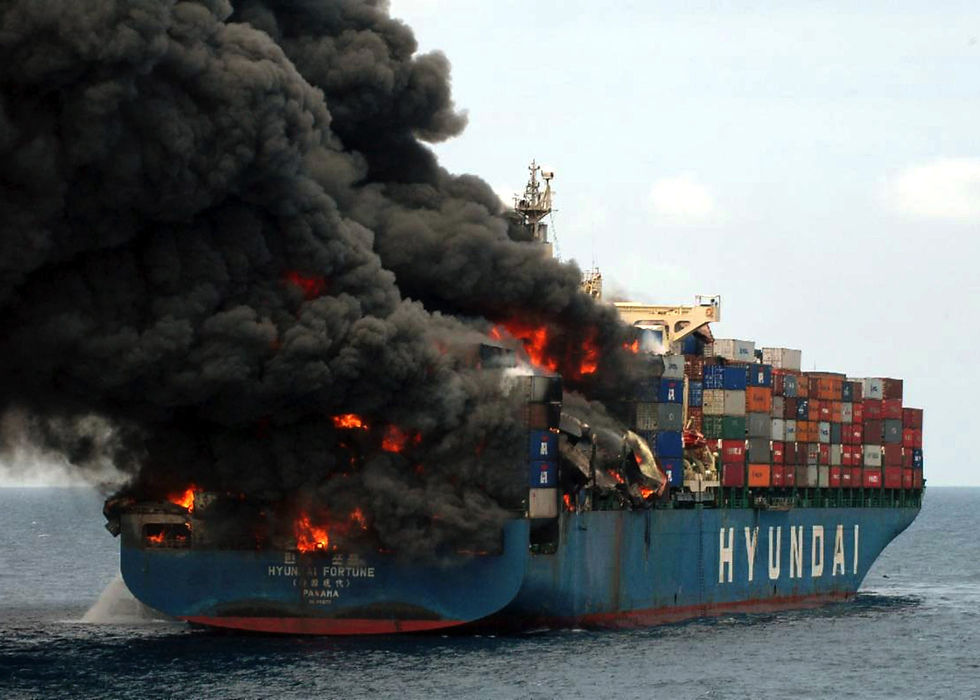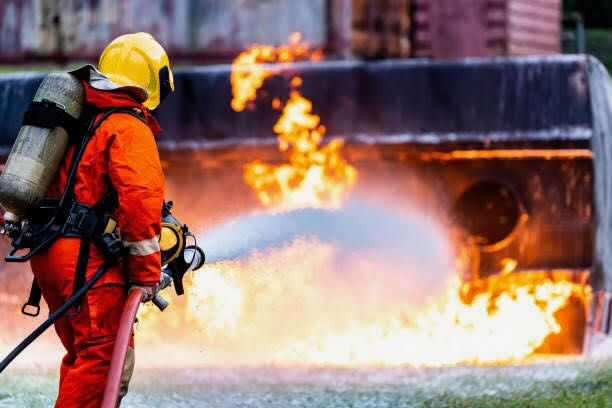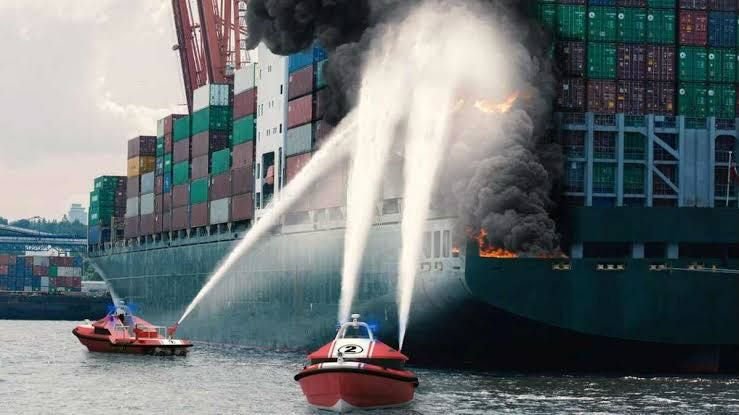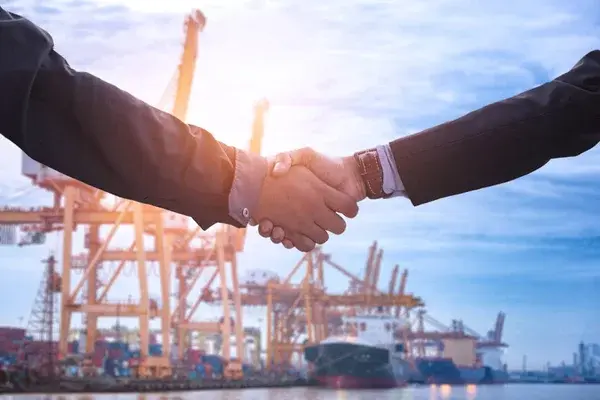Fire Onboard: Responding to an Emergency at Sea
- O’Shea Butler

- Jun 18
- 9 min read
Voyager Insights

Fire remains one of the most serious hazards onboard any vessel. Unlike on land, where external fire services can respond rapidly, ships must rely entirely on their own resources and trained personnel to manage and contain fire incidents. There’s no fire brigade speeding to your aid. It’s just you, your crew, and the equipment on board. A fire at sea can escalate rapidly due to limited escape routes, hazardous cargo, and a lack of resources.
Notable incidents include:
MV X-Press Pearl (May 15, 2021)
A chemical-laden container ship off Sri Lanka caught fire, leading to a catastrophic 12-day blaze. The vessel eventually sank, resulting in environmental damage and cargo losses of US $30–50 million.
MV Maersk Honam (March 6, 2018)
A devastating container ship fire erupted in the Arabian Sea. The blaze burned for over a month, claiming five lives. Salvage and general average costs eventually exceeded US $1 billion.
MV Wan Hai 503 (June 7, 2025)
A Singapore‑flagged container ship caught fire following an explosion about 88 nm off Kerala, India, carrying over 1,700 containers — 143 of which held dangerous goods.
North Sea Collision Fires (March 10, 2025)
Container ship (MV Solong) collided with the Oil Tanker MV Stena Immaculate in the North Sea off East Yorkshire. Both caught fire following explosions. Crews evacuated safely, though one crew member from Solong is presumed deceased. Firefighting tugs and aerial fire suppression were deployed.
Key Steps When Responding to a Fire Onboard
Sound the Alarm and Muster
Activate the fire alarm and muster crew per the Muster List. Every second counts.
Evacuate the Area
Shout “FIRE”! Get everyone’s attention and clear all non-essential personnel from the area as soon as possible. Give clear direction about how to evacuate (using hand signals). If there is accommodation nearby, don’t just knock on doors; rooms need to be entered and cleared for occupants. It’s significantly easier to do this while a fire is in its early stages, as smoke is minimal
Make an Initial Assessment
Identify the source. If safe, attempt to extinguish with nearby equipment. Fire can double in volume every 30-60 seconds, so attacking a fire in its early stages can have a huge influence on the outcome.
Determine the “hot zone,” check adjacent areas for spread, and assess threats to passengers or crew.
Communicate
Relay all key information to the Bridge or Engine Control Room (ECR) without delay. For those sailing aboard passenger ships, be sure to share information with passengers to minimise panic and prevent rumours from starting. This understanding not only calms individuals but also improves cooperation and ensures a more orderly, efficient response from both crew and passengers.
Suppress the Fire
Activate fixed fire suppression systems (CO₂, Water Mist, etc.).
Isolate electrical sources.
Close fire/watertight doors, dampers, and ventilation as needed
Manage ventilation to improve visibility, reduce heat and minimise the risk of backdraught.
Determine a Safe Staging Area
This should be close to the fire but protected from heat and smoke, with alternate exit routes. At least 2 Fire Screen Doors should exist between the staging area and the hot zone. Open deck spaces are ideal.
Form a Plan
Choose appropriate firefighting media based on the source (Water, Foam, CO₂, Fire Blanket).
Assign an attack team. Also, assign a backup team if manpower permits.
Designate search patterns (e.g., left-hand direct search).
Avoid ladders if alternate access is available.
Assign boundary cooling teams — remember a hot zone has six surfaces: above, below and 4 sides.
Prepare a medical/stretcher team with oxygen and an AED.
Attack Early
Delay increases danger exponentially.
Brief Fire Teams Thoroughly
Teams must know their destination, task, and what conditions to expect. All team members should use SCBA (regardless of smoke density). Have a BA Controller track the team’s location, air pressure and entry time.
Take the Right Gear
Don’t rely on equipment being in the hot zone, as first response, ship movement or explosions may have displaced it. Take hoses and extinguishers from the staging area. Make sure the hose is connected to a Hydrant outside the hot zone; this ensures the lifeline of the firefighters remains intact and gives them somewhere to safely retreat to if conditions deteriorate
Overhaul and Monitor
After extinguishing the fire, pull its source apart. Smouldering material presents a huge risk of re-ignition, so we need to be sure that the fire is fully extinguished. This means spreading out burnt material, pulling up carpets, pulling isolation off bulkheads to check behind, using infrared cameras/sensors to check for hotspots

Some Important Safety Considerations
Divisions and Bulkheads
Under SOLAS Chapter II-2, ships are required to have designated fire-resistant divisions to prevent the spread of fire and smoke.
A-Class bulkheads are constructed of steel or equivalent material and are capable of preventing the passage of smoke and flame for a certain time (eg A-60 meets requirements for 60 minutes), with insulation to limit temperature rise on the non-fire side. They are typically used between accommodation and machinery spaces, between decks and between main vertical zones.
B-Class bulkheads, while also non-combustible, allow smoke passage but prevent flame penetration for a certain time and have limited thermal insulation. These bulkheads are common divisions between general spaces onboard (eg workshops, offices & cabins)
An On-scene commander should be aware of the construction of their vessel and how they can use these bulkheads to their advantage. Knowledge of these bulkheads can help us determine priorities, especially when considering boundary cooling.
Carbon Dioxide (CO₂) Systems
- Conventional thinking is that CO₂ should be used as a last resort, due to its limited availability and seemingly “excessive” response. However, there is an argument that delays in use give a fire more opportunity to grow and increase in heat, reducing the effectiveness of the system when it is eventually deployed.
- Make sure the space is fully evacuated! CO₂ is heavier than air and will displace the oxygen within the space, rendering it uninhabitable. Test CO₂ Warning alarms frequently and make sure the crew working in CO₂-protected spaces are aware of the alarm and the nearest exits. Have a robust mustering system to check everyone is evacuated, and make sure this includes vistors/contracts who may also be in the space
- Before releasing the system, make sure that the Emergency Shut Down (ESD) sequence is fully complete (especially closure of doors, closure of fire dampers and shutdown of ventilation systems). Failure to do so could result in the loss of released CO₂, reducing its effectiveness.
- CO₂ has very little cooling effect, so there is a danger of re-ignition. Offensive Boundary cooling should be extensively used to reduce the temperature inside the space.
Do not re-enter until the space is fully ventilated. For large spaces, this could be more than 24 hours with fixed ventilation systems. Regardless of time, crew entering the space should do so wearing SCBA and utilise portable gas detection
Backdraught and Flashover
Backdraught and Flashover are important considerations when firefighting aboard vessels.
Backdraught occurs when the space has an ignition source and enough heat and fuel to burn, but not enough oxygen to support combustion to burn freely. An introduction of oxygen (such as opening a door or hatch) allows all the components of combustion to combine at once, causing a violent ignition of everything in the space. This can be controlled by prioritising ventilation, especially vertically; consider opening hatches above or accesses at the top of stairs to allow smoke and heat to escape while still allowing oxygen in
Flashover is a rapid transition to full-space involvement when temperatures exceed the ignition point of all combustibles. Everything within a space combusts at the same time, causing an intense burst of fire. Controlling the temperature inside the space is critical, which we can do by offensive boundary cooling outside the space, and by ventilating the hot smoke and gases. Firefighters inside the space should also use small bursts of water to create steam, converting the heat energy.
Boiling Liquid Expanding Vapour Explosion (B.L.E.V.E.)
Vessels often have pressurised cylinders onboard, either as cargo or for use onboard (such as Oxygen & Acetylene for welding). A B.L.E.V.E. occurs when the pressurised liquid inside a vessel reaches temperatures higher than that liquid’s boiling point. If the vessel can no longer contain the pressure inside the sealed tank due to the high temperatures, it will mechanically fail, causing the explosion.
If a fire occurs on or near pressure vessels, consider using large amounts of water to cool the cylinders & surrounding areas. Many vessels have fixed suppression or deluge systems to manage this, while keeping firefighters away from the area.
Dangerous Goods / Hazardous Material
The IMDG Code provides detailed guidance on fire response measures for each class of hazardous cargo, including the recommended extinguishing agents, protective equipment, and isolation procedures. When a fire occurs in a compartment containing dangerous goods, the crew should consult the Dangerous Goods Manifest and refer to the relevant Emergency Schedules (EmS) to determine the appropriate firefighting strategy.
Some substances may react violently with water or release toxic gases when heated, making it critical to avoid using incompatible extinguishing media.
Priority should also be given to boundary cooling to prevent the fire from spreading to adjacent containers with hazardous materials
Effectiveness of Boundary Cooling
There are two main methods of boundary cooling: Offensive & Defensive
Offensive Boundary Cooling supports an interior fire attack by lowering temperatures within the hot zone. Firefighters apply small amounts of water close to the fire (on bulkheads or decks adjacent), which converts to steam. This energy exchange draws more heat from the space into the bulkhead, thus lowering the temperature inside the space. This makes it easier for firefighters to work inside the space and reduces the risk of Flashover.
Defensive Boundary Cooling is used to protect critical areas and prevent the spread of fire. Copious amounts of water are applied to adjacent surfaces, keeping them cool. This helps steel maintain its structural integrity and prevents heat transfer by conduction. It does, however, prevent the extraction of heat from within the space, so it will result in high temperatures inside the hot zone. Use this method with caution when firefighters are in action inside the space.

Fire in Port
A fire in port should always be handled as though the vessel is at sea, but we have the benefit of additional resources. Upon a report of a fire, the Officer of the Watch should immediately
notify emergency services via the agent or Port Control on VHF.
Fire plans should be made available to emergency services (preferably at the gangway), and the on-scene commander should consider assigning crew to guide/assist local responders.
Not every country uses the same coupling on their fire hoses. For this reason, ships are fitted with an international shore connection. This can be used to connect to a local fire pump, providing pressure to the ship’s fire main in the event of a machinery failure.
Be EXTREMELY mindful of excessive firefighting water; this can affect the stability of the vessel due to free surface effect. Shore services do not normally need to worry about this in their daily lives, so they may need to be prompted. Firefighting boats/tugs may be used to assist (using fixed firefighting monitors). These have been known to rapidly flood vessels. In all cases, make sure bilge systems are functional and running.

Prevention is ALWAYS better than a cure
Know your high-risk areas onboard and create safety/response plans before an incident occurs; think aboard machinery/pump rooms, paint lockers, galleys & laundries.
Establish a fire-conscious culture on board. This starts from the top! A Captain or Chief Engineer who always promotes fire safety and training reinforces a great mindset among the crew.
Keep oily rags in sealed bins and empty them daily.
Maintain clean bilges and surfaces.
Ensure all exits are clear. This also means securing equipment so that it doesn’t shift in an emergency and block access.
Regularly inspect firefighting gear and appliances around the vessel.
Test smoke detectors and manual call points frequently
Make sure fire dampers, ventilators and emergency stops are fully functional
Keep Muster Lists current and make sure all crew understand the alarm signals and what their duty is at each alarm
Train and drill often — go beyond SOLAS minimums.
Ensure sufficient and capable crew are available at all times, especially during hot work or port stays.
Never force a frightened or overwhelmed crew member into a hot zone. The wrong person in the wrong mindset is a liability.

Fire is one of the most complex and high-risk emergencies a ship can face, requiring immediate & coordinated action from the entire crew. The absence of shoreside firefighting support at sea demands a high standard of preparedness, from technical knowledge and tactical planning to clear communication and teamwork. Understanding fire behaviour, using strategies like boundary cooling, and considering the risks posed by dangerous goods and ship-specific systems improve the chances of controlling an incident before it escalates. Regular training, strong leadership, and a proactive safety culture are essential and should be part of everyday life onboard.
Want to train your crew beyond the minimums, or develop more robust safety & response plans aboard your vessels? Reach out to Voyager Marine Solutions for advanced onboard firefighting training, emergency response planning, and ISM/MOSS support.

About the Author

O'Shea is a Maritime Consultant, Examiner and Master Mariner based in Nelson, New Zealand. With over 15 years at sea aboard passenger ships, he has sailed to more than 90 countries. More recently, he has started Voyager Marine Education, preparing and examining maritime students, as well as offering expert-led courses and mentoring. O’Shea combines real-world experience with a passion for teaching the next generation of seafarers.




Comments